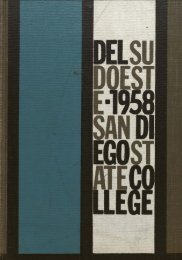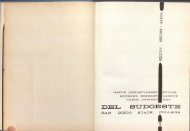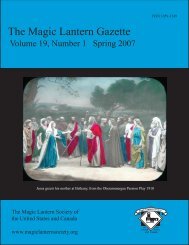The Magic Lantern Gazette - Library
The Magic Lantern Gazette - Library
The Magic Lantern Gazette - Library
You also want an ePaper? Increase the reach of your titles
YUMPU automatically turns print PDFs into web optimized ePapers that Google loves.
Feature Article 9<br />
<strong>The</strong> Early <strong>Magic</strong> <strong>Lantern</strong>s: Where are <strong>The</strong>y?<br />
Erkki Huhtamo<br />
UCLA Department of Design /Media Arts<br />
Broad Art Center, Rm. 2275, Box 951456,<br />
Los Angeles, CA 90095-1456 (erhuhta@ucla.edu)<br />
Regularly observing eBay-listings for magic lanterns (in my<br />
case for nearly ten years) can give us valuable hints about<br />
their production and dissemination. <strong>The</strong> crushing dominance<br />
of the Nuremberg toy company Ernst Plank in the<br />
U.S. market for toy lanterns has been clearly established.<br />
When it comes to American-made professional lanterns,<br />
McIntosh and later Bausch & Lomb seem to have been way<br />
ahead of competitors in their marketing efforts. Yet, observations<br />
like these don’t tell the whole, and perhaps not even<br />
the true, story.<br />
Why have certain lanterns been preserved and others disappeared<br />
without a trace? How important is pure chance – the<br />
“attic factor”? <strong>The</strong> sheer quantity of production cannot be<br />
the only answer. <strong>The</strong>re are lanterns that were popular in<br />
their time, and yet have become very rare today. A case in<br />
point, of the well-known bi-unials made by the famous<br />
French maker Alfred Molteni, only two are known to survive.<br />
1<br />
Some lanterns were perhaps powerful, but bulky or aesthetically<br />
so unattractive that they were thrown away when they<br />
were no longer needed. Or they may have been nicelooking,<br />
but impractical and difficult to use. Some models<br />
may have had more value as scrap metal than others. Some<br />
may have rusted easily. Certain lanterns may have been<br />
easier to convert to electricity. And so on.<br />
<strong>The</strong> further back in time we go, the more difficult it becomes<br />
to find preserved magic lanterns. Here the mode of<br />
production certainly matters. Industrial serial production of<br />
machines and mechanical devices began to develop slowly<br />
with the onset of the first industrial revolution. Especially in<br />
the United States, the “American system,” aiming at quantity<br />
production using interchangeable parts and eventually<br />
the assembly line, was first applied to things like firearms<br />
and agricultural machinery. <strong>The</strong>ir practical effectiveness<br />
and “useful ugliness” made an impression on the visitors of<br />
the Crystal Palace Exhibition (1851), spurring others to<br />
adopt similar methods.<br />
With very few exceptions, possibly those of Philip Carpenter<br />
(later Carpenter & Westley) in England and the Nuremberg<br />
metal workshops in Germany, anything like industrial<br />
“quantity production” of magic lanterns and slides does not<br />
seem to have existed before the 1850s.<br />
<strong>Magic</strong> lanterns were produced by opticians and tinsmiths in<br />
their workshops. <strong>The</strong>re were some identifiable “types,” influenced<br />
by published illustrations or artisanal traditions. Even<br />
then, the individual lanterns were rarely identical, which possibly<br />
signifies that they were made by different workshops for the<br />
same wholeseller or retailer. 2<br />
Although the evidence is fragmentary, it is also likely that many<br />
early lanterns were unique objects, made upon order for a client<br />
with specific needs (the enormous 18th century demonstration<br />
lantern preserved at the Harvard university being a good example).<br />
3<br />
This explains partly why early magic lanterns are so rare. Very<br />
few lanterns made before the 1850s have ever appeared on<br />
eBay. <strong>The</strong> exceptions I can think about include three fantascopes<br />
and some hand-crafted miniature tin toy lanterns, all<br />
very probably from the first half of the 19th century. <strong>The</strong>re<br />
have been no examples of 18th century lanterns that I am aware<br />
of, although some early slides have appeared a few times. <strong>The</strong>y<br />
seem to have generally survived better than the lanterns, partly<br />
thanks to their small size, aesthetic quality and value as collectables.<br />
<strong>Lantern</strong> Treasures along the Route<br />
So where, if anywhere, are the magic lanterns produced during<br />
the first two hundred years? As David Robinson’s invaluable<br />
iconography <strong>The</strong> <strong>Lantern</strong> Image demonstrates, plentiful illustrations<br />
of early lanterns exist, but how accurate are they? 4 Were<br />
the lanterns displayed in the paintings and engravings modeled<br />
on existing ones, or pure products of the imagination? How<br />
about more the more technical illustrations? Are comparisons<br />
with surviving lanterns possible? <strong>The</strong> total lantern production<br />
cannot have been very large, and just a small fraction has been<br />
preserved. Where are the survivors?<br />
We may look toward seasoned collectors like Francois Binetruy,<br />
who has gathered some stunning examples over the years. 5<br />
Institutions such as the Cinema Museum of the French Cinémathèque<br />
and the Turin Film Museum also possess rare material,<br />
although with few exceptions their collections only contain<br />
lanterns dating from the end of the 18th century onward (the<br />
phantasmagoria era). 6 Are there other places to look to?

















